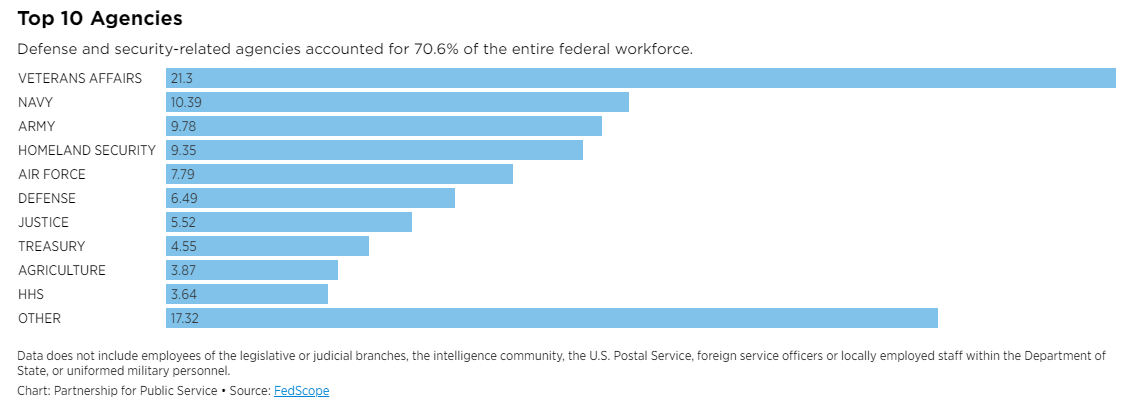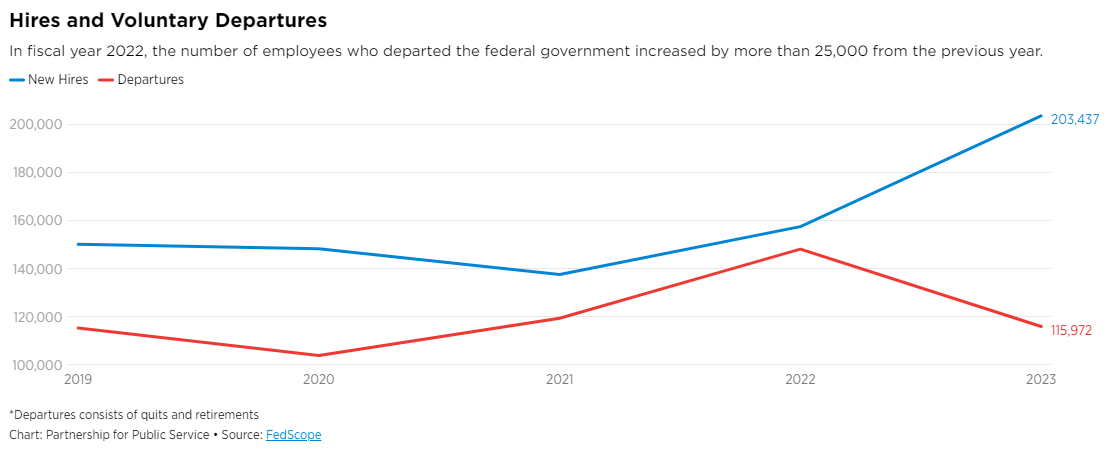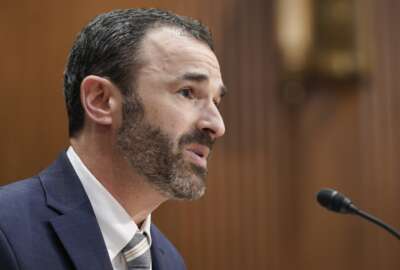The federal workforce is growing, as House appropriators consider agency spending cuts
Despite a growing federal workforce, current budget deliberations in Congress could cause the pendulum to eventually swing back in the other direction.
With a net gain of more than 80,000 civilian employees during fiscal 2023, the federal workforce posted yet another year of growth.
Between 2019 and 2023, more than 140,000 employees joined the civil service, an increase of about 7%, according to data that the non-partisan, non-profit Partnership for Public Service compiled and released this week.
The majority of the growth in the past couple of years occurred in 2023 alone — the federal workforce grew by 4% in just that one year, the Partnership said. The latest increase brings the grand total of full-time federal employees to just over 2 million.
“These professionals play a crucial role in protecting our national security, promoting public health, driving economic development and more,” the Partnership wrote in its data report, published Monday. “They are a fundamental part of a well-functioning government.”
But despite the federal workforce growth on the whole, current budget deliberations in Congress could cause the pendulum to eventually swing back in the other direction.
As House appropriators work through a stack of 2025 spending bills, it’s clear the GOP-led committee is eyeing significant spending cuts for many agencies. The committee’s financial services and general government bill, for instance, would put agencies covered by the legislation 20% below the Biden administration’s budget request and 10% below the 2024 allocation.
Some Democratic committee members have warned that limiting agencies’ budgets could lead to hiring freezes and staff layoffs, coupled with worsening federal services as a result.
If appropriations are reduced for 2025, “our agencies have to lay off staff, severely undermining their ability to function at the most basic levels,” Rep. Steny Hoyer (D-Md.) said in June. “That has direct consequences on the American people.”
Workforce growth, attrition rates and more
The Partnership’s new report on the federal workforce uses data from FedScope, the Office of Personnel Management’s online data source on federal employees.
Discounting the Postal Service, 71% of the entire civilian federal workforce is housed in defense and national security-related agencies, the Partnership said.

A large portion of government positions are in public health, as well as general administration and office roles.
In total, agencies hired more than 200,000 employees last fiscal year — an increase of more than 45,000 hires over the previous year, the Partnership said. That doesn’t account for attrition due to retirements and others leaving the government. Encompassing all the changes brings the net gain to about 80,000 employees.

During 2023, 52% of those leaving government quit their positions, while 48% retired. Overall, the attrition rate last fiscal year was 5.9%. That’s lower than the 7.6% attrition rate in 2022, but close to the 6.1% attrition rate the government saw in 2021 , the Partnership said.
Notably, though, the attrition rate of federal employees under 30 years old was 9% in 2023, significantly higher than the overall figure.
“Federal agencies must recruit young talent and employees with the necessary skills for both current and future needs,” the Partnership said. “Ensuring a diverse workforce is essential, as is developing leadership capabilities within the organization, improving hiring processes and implementing policies to retain high-performing workers. These measures collectively enable the federal government to effectively address both present and emerging challenges effectively while fostering an environment that attracts and retains top talent.”
Agencies dealing with fluctuating budgets
But due to budget changes and limitations that came out of the 2024 government spending package, the picture is in flux for many agencies. The Environmental Protection Agency, National Science Foundation and NASA, for instance, all saw large cuts in their 2024 appropriations.
Many agencies are constantly grappling with trying to right-size their staffing. The Department of Veterans Affairs is scaling back hiring for its health care workforce. The Equal Employment Opportunity Commission is trying to manage under a current hiring freeze.
The Social Security Administration is struggling to rebuild staffing after a hiring freeze that just ended. The Forest Service has just lifted a hiring pause, but for now it’s only planning to fill its most critical vacancies.
Other agencies have big hiring goals for the rest of 2024. The IRS is planning to make 20,000 new hires by this September. But for 2025, IRS is facing a possible budget cut of more than 18%, according to the proposal last month from House appropriators.
Another 2025 spending bill from House appropriators aims to cut the Centers for Disease Control and Prevention’s budget by 22%, or $1.7 billion, while also looking to eliminate 23 of the CDC’s programs.
House appropriators have so far passed three of their 12 spending bills, largely along party lines. With most Democrats opposed to the proposed appropriations levels in the House, agency budgets for 2025 likely won’t be determined for months to come.
The Senate has yet to release or take up its versions of 2025 government spending bills. Various statements of administrative policy from the White House have also threatened to veto several of the House’s spending bills in their current form.
Copyright © 2025 Federal News Network. All rights reserved. This website is not intended for users located within the European Economic Area.
Drew Friedman is a workforce, pay and benefits reporter for Federal News Network.
Follow @dfriedmanWFED






